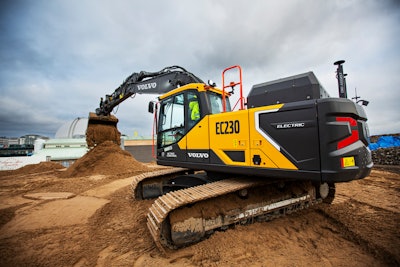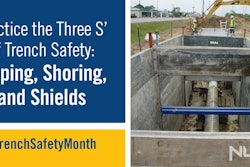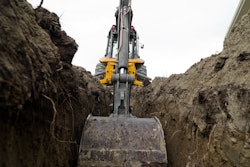
Qualified contractors in California can soon tap into more than $182 million in funds to purchase zero-emissions construction equipment through the California Air Resources Board’s Clean Off-Road Equipment Voucher Incentive Program (CORE).
CORE project administrator CALSTART will open the fiscal year 2022-2023 CORE funding at 9 a.m. PST on July 18. Purchasers and lessees of zero-emission off-road equipment are issued a point-of-sale cash rebate on a first-come, first-served basis, with increased incentives for equipment located in disadvantaged communities and small businesses.
Intended to offset the higher cost of green technologies, the CORE voucher amounts are based on the incremental cost difference between traditional equipment and new zero-emission alternatives. CORE says it targets commercial-ready products that have “not yet achieved a significant market foothold.”
A list of eligible construction equipment can be found on CORE’s website, with incentives ranging from $34,000 for skid steers to $500,000 for cranes. Manufacturers on the approved list include Bobcat, First Green Industries, JCB, Liebherr and Volvo CE.
To be considered for voucher eligibility, the purchased equipment must be kept and operated in California for at least three years after the voucher redemption date. Purchasers must also submit activity reports during those three years.
CORE says fleet size does not affect voucher amounts and purchasers are not limited to the number of vouchers they can apply for.
Through the program, CORE aims to reduce emissions, help build confidence in zero-emission technology and provide other sector-wide benefits, such as technology transferability, reductions in advanced-technology component costs, and larger infrastructure investments.
But are the incentives enough?
Originally only for freight, CORE expanded to include funding for the commercial harbor craft, agriculture and construction sectors in 2022. But critics say the funds may not be enough to help businesses comply with the crushing regulations CARB has put in place.
The Biden administration cleared the way on March 31 for California to require that half of all heavy trucks sold in the state be fully electric by 2035, and the state becomes the world’s first government to require zero-emission trucks. California needed the White House's approval because its rule exceeded Environmental Protection Agency (EPA) requirements.
CARB ultimately approved the Advanced Clean Fleets rule on April 30, requiring companies with $50 million in annual gross revenue and one truck, companies with 50 or more trucks, or dispatch fleets to begin their transition toward zero-emissions vehicles in 2024 with an ultimate goal of no emissions-producing trucks in the state by 2045. CARB will also begin preparing a new rule for the 1.2 million trucks in fleets under 50 vehicles unaffected by this fleet rule.
While the ruling will impact many construction companies, it will have damaging effects on a vast swath of the economy as almost all goods are carried by truck. The move was blasted by American Trucking Associations President and CEO Chris Spear, with Spear saying, "The EPA is handing over the keys as a national regulator. This isn’t the United States of California, and in order to mollify a never satisfied fringe environmental lobby by allowing the state to proceed with these technologically infeasible rules on unworkable and unrealistic timelines, the EPA is sowing the ground for a future supply chain crisis.“
Beyond the new truck regulations, amendments to CARB’s In-Use Off-Road Diesel regulations also go into effect next year.
According to the Associated General Contractors of California, the new schedule, beginning on January 1, 2024, is as follows:
- Ban on adding Tier 3s: Large, medium, and small fleets may not add a vehicle with a Tier 3 engine to their fleet. The engine tier must be Tier 4 interim or higher.
- Ban on adding Tier 4 interims: Beginning January 1, 2024, for large and medium fleets, and January 1, 2028, for small fleets, a fleet may not add a vehicle with a Tier 4 interim engine to its fleet. The engine tier must be Tier 4 final or higher.
- Ban on adding Tier 4 interims for fleets with 500 hp or less: A fleet that chooses to comply with the requirements of 2449(e)(16) is not subject to the small fleet Tier 4 interim vehicle adding provision. Instead, beginning January 1, 2035, a fleet that chooses to comply with the requirements of 2449(e)(16) may not add a vehicle with a Tier 4 interim engine to its fleet.
- Ban on adding vehicles powered by a model year 2006 or earlier on-road engine: Beginning January 1, 2024, for large and medium fleets, and January 1, 2028 for small fleets, a fleet may not add a vehicle powered by a model year 2006 or earlier on-road engine to its fleet. To be added to a fleet, a vehicle powered by an on-road engine would need to be powered by an on-road engine that is model year 2007 or later.
- Ban on adding Tier 0s to special provisions: Beginning January 1, 2024 for large, medium, and small fleets, a fleet may not add a vehicle with a Tier 0 engine to its fleet as a vehicle designated as a dedicated snow removal vehicle, a vehicle used for emergency operations, or a Job Corps vehicle.
The Off-Road Diesel Regulation also imposes limits on idling, requires a written idling policy, and requires a disclosure when selling vehicles; requires all vehicles to be reported to CARB in the online reporting system DOORS and labeled; and requires fleets to reduce their emissions by retiring, replacing, or repowering older engines, or installing exhaust retrofits.
Industry groups, including AGC and the Construction Industry Air Quality Coalition, vehemently oppose the regulation and are working to “demonstrate numerous implementation problems and fatal flaws with the Off-Road Regulation, including safety issues with retrofits, the state of the economy and inability of the industry to afford equipment turnover, and the lack of available emission reduction technologies required for regulatory compliance.”












